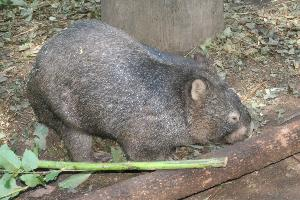
Poids et mesures
| Longueur | de 70 à 120 cm |
|---|---|
| Longueur de la queue | de 2 à 3 cm |
Description de l'animal
The Common wombat (Vombatus ursinus) is a fascinating marsupial native to Australia, recognized for its distinctive appearance and intriguing behaviors. This robust creature, often described as resembling a small bear, plays a significant role in the ecosystems of southeastern Australia, including Tasmania. The Common wombat is the largest burrowing herbivorous mammal, known for its sturdy and compact body, which is well-adapted to its digging lifestyle.Characterized by a broad head, short neck, and large, strong limbs equipped with sharp claws, the Common wombat is perfectly designed for excavation. Its fur, which can range in color from sandy brown to gray and even black, provides both camouflage and protection from the elements. One of the most unique features of this animal is its backward-facing pouch, a clever adaptation that prevents soil from entering the pouch while the mother digs, thus protecting her young.
Wombats are nocturnal and crepuscular, meaning they are most active during the night and twilight hours. During the day, they seek refuge in the intricate burrow systems they construct, which can be quite extensive and serve as protection against predators and extreme weather conditions. These burrows are a testament to the wombat's engineering skills, with some tunnel systems being used by generations of wombats.
The diet of the Common wombat primarily consists of grasses, herbs, bark, and roots. Their strong jaws and specialized teeth allow them to grind down tough vegetation, a trait that is crucial for their survival in the often harsh Australian landscape. Remarkably, wombats have a very slow metabolism, which means they can take up to 14 days to fully digest their food. This slow digestion process is advantageous during periods of drought or food scarcity, as it allows them to extract the maximum amount of nutrients from their diet.
One of the most endearing aspects of the Common wombat is its social behavior. While they are generally solitary animals, they exhibit a complex social structure through the use of scent marking and vocal communications. Wombats use their droppings, which are notably cube-shaped due to their unique digestive process, to mark their territory and communicate with other wombats.
Despite their sturdy appearance and formidable digging abilities, Common wombats face several threats, including habitat loss due to agricultural development, road accidents, and diseases such as mange, which is caused by mite infestations. Conservation efforts are in place to protect these unique animals and their habitat, including research into disease management, the establishment of wildlife corridors, and public education campaigns to reduce vehicle collisions.
In conclusion, the Common wombat is an extraordinary creature that captivates the interest of scientists, conservationists, and the general public alike. Its unique adaptations, from backward-facing pouches to cube-shaped droppings, highlight the incredible diversity of life on Earth and underscore the importance of preserving natural habitats for future generations to enjoy and study.
Carte de répartition

Nouvelles photos d'animaux
Top 10 des animaux
- Dolphin gull (Leucophaeus scoresbii)
- Japanese macaque (Macaca fuscata)
- Greek tortoise (Testudo graeca)
- Stone loach (Barbatula barbatula)
- Russian tortoise (Testudo horsfieldii)
- Galápagos tortoise (Geochelone nigra complex)
- Diana monkey (Cercopithecus diana)
- Moustached guenon (Cercopithecus cephus)
- Common flying dragon (Draco volans)
- Galápagos penguin (Spheniscus mendiculus)